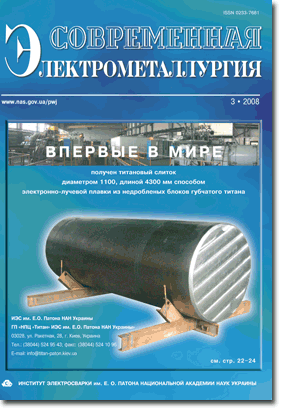

To 75th Anniversary of OJSC «Ukrainian Graphite» Development of scientific-production base for manufacturing electrode products at OJSC «Ukrainian Graphite» 2
ELECTROSLAG TECHNOLOGY
Zhadkevich M.L., Shevtsov V.L. and Puzrin L.G. Electroslag casting of hollow ingots and billets in industrial production (Review) 6
Methods of manufacture of hollow ingots and billets by electroslag casting (ESC), widely distributed in the industry, are considered. Systematization of the ESC methods is made by specifics of mutual movement of external and internal moulds and a billet being melted. Capabilities, advantages and drawbacks of different methods of ESC of hollow billets and principles of the mold movement process control are analyzed. Examples of effective application in industry of hollow ingots and billets, produced by ESC and designed for subsequent deformation or application in a cast form, are given.
Skripnik S.V., Chernega D.F. and Goryachek A.V. Investigation of quality of the 20Kh13 steel cone billets produced by method of centrifugal electroslag casting 13
Information about chemical composition, structure and mechanical properties of the 20Kh13 electroslag steel in comparison with forged steel of similar composition is given. Possibility of application of the CESC billets from this steel in production of housing parts of gas turbines is substantiated.
Tsykulenko K.A. and Vislobokov O.M. Physical modeling of slag pool hydrodynamics in slab current-leading mould.Part 2. Cladding 17
Hydrodynamics of a slag pool in a slab current-leading mould for the process of cladding has been investigated. It is shown that character of hydrodynamic flows in the slag pool depends upon ratio of parameters of the layer being clad and distance between the current-leading section and the metal pool level in the mould. Distribution of current both along circuit of electrodes of the mould current-leading section and over the whole volume of the pool is investigated.
ELECTRON BEAM PROCESSES
Paton B.E., Trigub N.P., Zhuk G.V. and Berezos V.A. Development of electron beam melting of titanium in the E.O.Paton Electric Welding Institute 21
Production of titanium ingots from uncrushed blocks of spongy titanium using method of electron beam melting is described. Values of melting efficiency for 1200 and 850 mm diameter ingots are determined at which depth of the molten pool does not exceed radius of the ingot, that ensures a satisfactory result from the viewpoint of theory of crystallization. High quality of produced ingots of 1100 mm diameter is shown.
Tugaj B.A. Automatic control of current of gas-discharge electron gun with cold cathode 24
Issues of automatic control of current of automatic electron guns on basis of high-voltage glow discharge with cold cathode by change of pressure in the gun at its continuous pump-down and regulated bleeding-in using low-inertia electromagnetic leak are considered. Mathematical model of automatic control of the gas-discharge gun current and its solution on a computer are presented. Influence of the gas-dynamic characteristics of the gas pump-down and bleeding-in systems on process of control is shown, and comparison of calculated and experimental transient characteristics of current control of the gas-discharge electron gun for spraying is made.
Yakovchuk K.Yu., Didikin G.G., Romanenko S.M., Litvin S.E., Skryabinsky V.V. and Marinsky A.G. Condensation erosion-resistant coatings on basis of boron carbide 31
Feasibility of using commercially produced boron carbide for production of erosion-resistant coatings by method of electron beam evaporation in vacuum is demonstrated. Results of investigation of chemical composition of the material on basis of boron carbide, structures and some properties of erosion-resistant B4C-base coatings, deposited from vapor phase, are presented.
Savenko V.A., Grechanyuk N.I. and Churakov O.V. Electron beam refining of platinum and platinum-base alloys. Information 2. Electron beam refining of platinum-base alloys 36
Detailed investigation of refining of platinum-base alloys was carried out. Industrial electron beam technology for production of platinum-base alloys has been developed.
PLASMA-ARC TECHNOLOGY
Shapovalov V.A., Nikitenko Yu.A. and Melnik A.S. Thermal state of drum-cooler of plasma-arc installation in process of superfast melt hardening 40
Mathematical model of thermal state of the drum-cooler is suggested. Influence of its geometric dimensions on rate of hardening of a strip of amorphous structure was studied.
ELECTROMETALLURGY OF STEEL AND FERROALLOYS
Panchenko A.I., Logozinsky I.N., Salnikov A.S., Mazuruk S.L., Kasian S.A., Kazakov S.S., Skripka L.M., Gasik M.I., Gorobets A.P. and Sezonenko O.N. Development and mastering of deoxidation and alloying technology of ShKh15SG-V bearing steel using MnS25 ferromanganese silicon 44
Results of experimental-industrial mastering of the ShKh15SG-V bearing steel melting by application of the MnS25 ferromanganese silicon (DSTU 3548-97) with weight share of calcium not more than 0.1 % instead of the FMn78A (DSTU 3547-97) ferromanganese and the FS65 (DSTU 4127-2002) ferrosilicon with high (up to 0.5 %) and unstable content of calcium are presented. Use of national ferroalloys instead of imported ferrosilicon according to the developed innovation technology of melting and ladle treatment of steel ensures significant increase of efficient metal yield and enables reduction of contamination of the billets and sectioned rolled stock by globular and oxide inclusions.
Troyansky A.A. and Sinyakov R.V. Identification of technological events in melting of steel in arc steel furnace using wavelet-analysis 55
The scheme has been developed for obtaining real-time information about arc voltage and state of the technological process. Using the wavelet-analysis the algorithm for digital processing of a signal was developed, using which it is possible to perform its noise suppression and compression. The algorithm for identification of technological events has been developed that allows determining them at early stage of occurrence. Complex of programs has been developed, which makes it possible to record a signal about arc voltage, register events that correspond to certain moments of the signal readout, carry out digital processing (noise suppression and compression) and form image of the technological event.
Developed at PWI 16, 39, 60
(You are viewing the simplified file contents)
